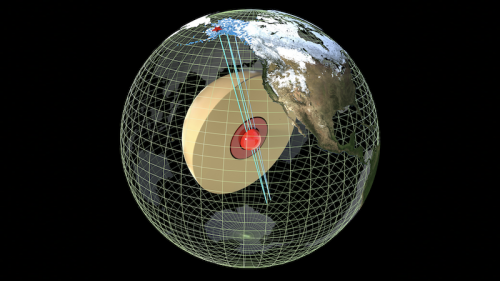
P‐wave microseisms are excited by ocean swell activities. Each panel spans a 48 h long period indicated atop of it. Figures 7a and 7b show contours that include 40% (dark red and green lines) and 90% (light red and green lines) of the strongest “effective” sources, while Figures 7c and 7d show contours that include 90% only. For a selection of stations (those for which the model satisfies the data, see Appendix A), we also show contours of the surface “effective” sources, i.e., taking into account attenuation and geometrical spreading (equation (A2)). These estimates were obtained using a polarization analysis of noise records performed in the range 0.184–0.202 Hz, which covers one frequency step of the wave-noise model around 0.193 Hz. The azimuthal histograms show estimates of the incoming direction of the surface waves at GSN (Global Seismic Network) stations close to the storm tracks.

The background images are maps of the surface wave sources (SDF in equation (A1)) generated at 0.193 Hz (the frequency used to compute body waves). Sources of microseismic surface (Rayleigh) waves during the (a and b) 16 to 23 September 2010 and (c and d) 24 to 27 September 2010 microseismic events. Our study demonstrates the potential of numerical modeling to provide fast and accurate constraints on where and when to expect microseismic body waves, with implications for seismic imaging and climate studies. The different patterns between body- and surface-waves result from distinctive amplification of ocean wave-induced pressure perturbation and different seismic attenuation. We also use these two specific noise bursts to illustrate the differences between microseismic body- and surface-waves in terms of source distribution and resulting recordable ground motion. We then emphasize two particularly strong storms to describe how they generate noise sources in their wake. They are mostly induced in the open ocean, at or near water depths of 28 km, most likely within storms or where ocean waves propagating as swell meet another swell or wind sea. These ~75 noise sources exhibit a highly heterogeneous distribution, and cluster along the usual storm tracks in the Pacific and Atlantic oceans.

The locations and relative strengths of the computed sources are validated by the good agreement with beam-forming analysis. The South California Seismic Network (SCSN) and analyze the most significant discrete sources. We compute sources at ~ 0.2 Hz within typical P teleseismic distances (30-90 degrees) from Here we first validate recent improvements in numerical modeling of microseismic compressional (P) body waves and then show how this tool allows fast detection and location of their sources. Among the different types of waves embedded in seismic noise, body waves present appealing properties but are still challenging to extract.


 0 kommentar(er)
0 kommentar(er)
